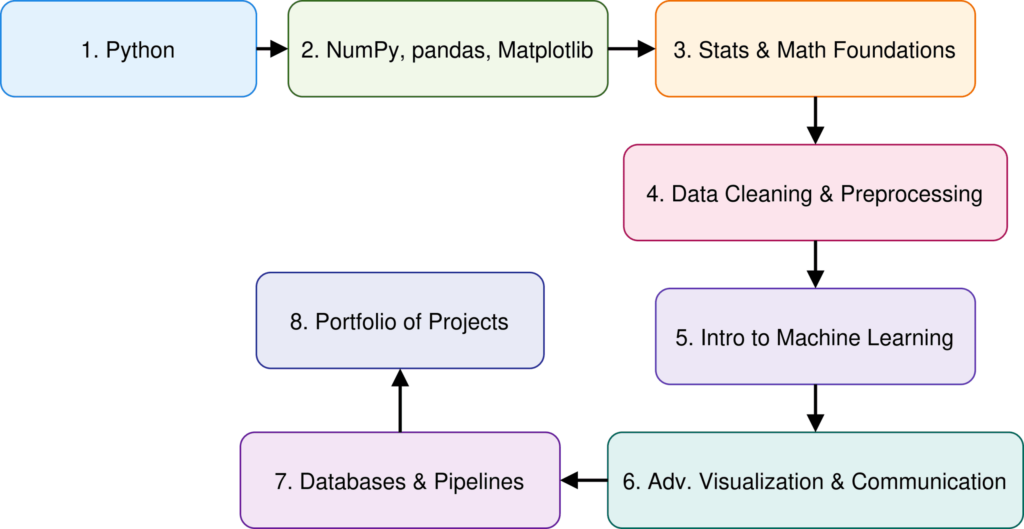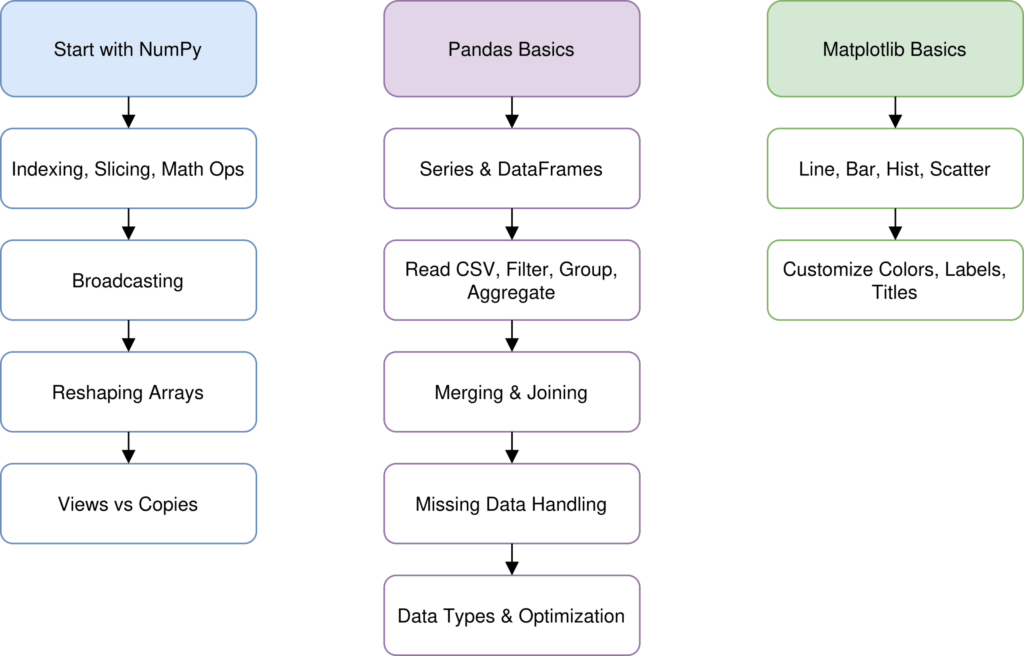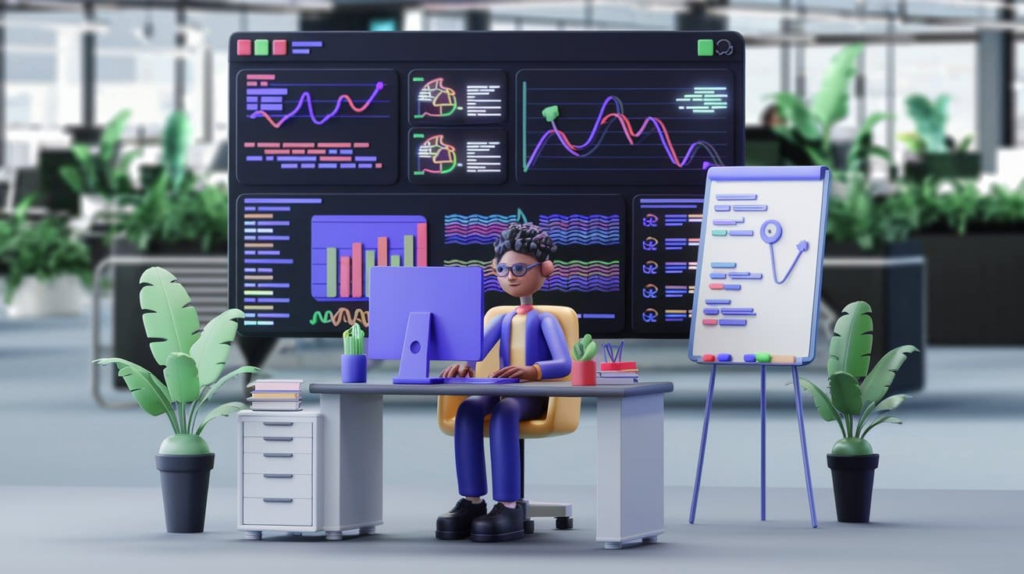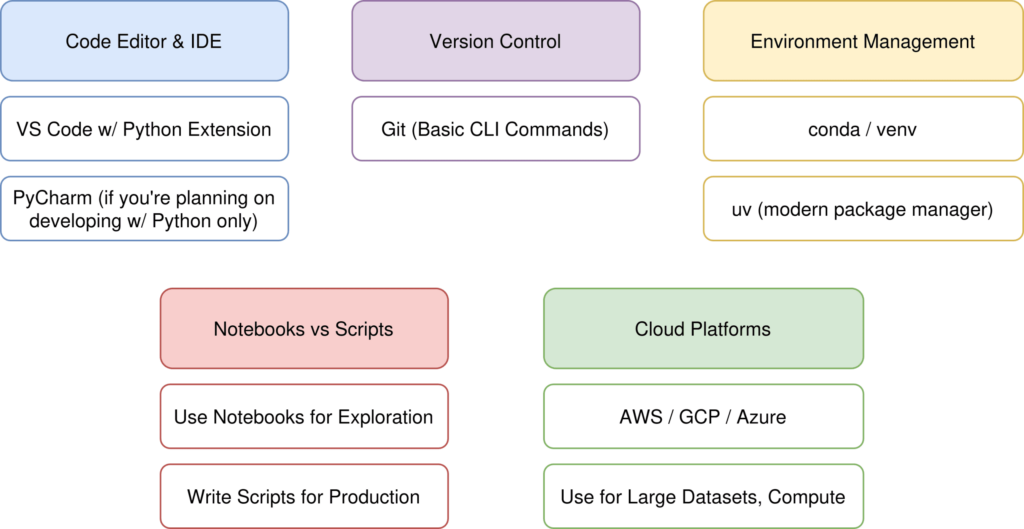If you’ve landed here, you’re likely wondering: Is data science still a viable career path in 2025 and beyond? The answer is yes. This field continues to offer exciting career opportunities and the ability to solve real-world problems using data.
However, many beginners feel overwhelmed by the wide range of algorithms, math concepts, and programming tools. So, how do you learn programming for data science without getting lost along the way?
This roadmap will guide you step-by-step, so you can move from absolute beginner to confident data scientist.

Part 1: Python Fundamentals
To begin with, if you have any math or basic coding background, start with Python. It’s the top choice for data science because of its simplicity and vast range of libraries.
Focus on these foundational concepts:
- Variables and data types
- Control structures (if/else, loops)
- Functions (with arguments and return values)
- Built-in data structures: lists, dictionaries, sets, tuples
- Error handling with
try/exceptblocks - Scope and variable behavior in functions
In addition, building small projects like password generators or simple games will help develop muscle memory. As a result, Python syntax will start to feel second nature before you move on to more advanced topics.
Part 2: Essential Data Science Libraries
Once you’re comfortable with Python basics, it’s time to explore libraries that bring your data to life.

Three key libraries to master:
- NumPy: Learn about arrays, slicing, math operations, broadcasting, and reshaping.
- Pandas: Explore dataframes, read from CSV/parquet, filter and group data, and handle missing values.
- Matplotlib: Begin with line charts and bar plots. Then, gradually customize them with labels, colors, and subplots.
Moreover, practice with real datasets. For instance, try analyzing your city’s public data or open datasets like those from the World Bank. Clean, explore, and visualize your findings to reinforce what you’ve learned.
Part 3: Statistics and Mathematical Foundations

Although you don’t need an advanced degree in math, understanding core statistical concepts is essential.
Topics to cover:
- Descriptive statistics (mean, median, standard deviation)
- Probability basics: independence, conditional probability, and key distributions (normal, binomial, Poisson)
- Hypothesis testing: p-values, null/alternative hypotheses, confidence intervals, and errors (Type I and II)
For example, using scipy.stats will allow you to conduct real hypothesis tests. Therefore, your statistical insights will have a solid foundation.
Part 4: Data Cleaning and Preprocessing
In real-world scenarios, data is rarely clean. Consequently, you’ll need to spend significant time cleaning and preparing it.
Key techniques:
- Handling missing data (MCAR, MAR, MNAR)
- Encoding categorical variables (one-hot, ordinal)
- Converting and standardizing data types
- Scaling data with normalization or standardization
- String cleaning using regex
- Removing duplicates and detecting outliers
Furthermore, working with different file types—like CSV, Excel, JSON, and SQL—will prepare you for diverse data sources.
Part 5: Introduction to Machine Learning
By this stage, you’ll be ready to dive into machine learning. It’s the part that most beginners look forward to—rightfully so!
Start with:
- Regression (e.g., predicting house prices)
- Classification (e.g., detecting spam emails)
Core ML concepts to grasp:
- Splitting data (train/test/validation)
- Cross-validation
- Avoiding overfitting and underfitting
- Feature selection and reduction
- Evaluation metrics (accuracy, precision, recall, F1)
For instance, with scikit-learn, you can quickly implement models and evaluate performance. Therefore, you’ll gain a hands-on understanding of how these algorithms function.
Part 6: Advanced Visualization and Communication

Ultimately, data science is about turning insights into action. Therefore, being able to visualize and communicate findings is just as important as analyzing them.
Tools and techniques to explore:
- Seaborn for visual statistics
- Plotly for interactive visuals
- Heatmaps, box plots, violin plots, and scatter plots
- Dashboard creation basics
Moreover, learn to tailor your visual stories to your audience. Whether it’s a business executive or fellow data scientist, your ability to convey insights clearly will set you apart.
Part 7: Introduction to Databases and Data Pipelines

At this point, you’ll want to learn SQL—an essential tool for querying and analyzing structured data.
Start by mastering:
- SELECT, WHERE, JOINs (inner, outer, etc.)
- Aggregations and GROUP BY
- Subqueries and window functions
- Performance optimization
In addition, practice integrating SQL with Python using pandas.read_sql() or SQLAlchemy. As a result, you’ll be able to create basic data pipelines and automate your workflows effectively.
Part 8: Building Your Portfolio
Your portfolio demonstrates your capability in real terms. Therefore, don’t wait to start building it.
Must-have portfolio projects:
- A data cleaning project that shows before/after results
- An exploratory analysis with clear insights and visualizations
- A full machine learning pipeline from raw data to evaluation
- A storytelling visualization (e.g., climate trends in your city)
Moreover, host everything on GitHub. Use well-written README files to explain the project, your approach, and how to run the code.
Essential Tools and Development Environment

Set up your toolkit:
- VS Code or PyCharm for coding
- Git and GitHub for version control
- Conda or
venvfor managing environments - Jupyter Notebooks for prototyping
- AWS, GCP, or Azure for cloud-based processing
In addition, track milestones such as:
- Completing your first end-to-end data project
- Presenting findings to non-technical audiences
- Contributing to open-source repositories
- Landing your first job in data science
Wrapping Up
In summary, the journey to learn programming for data science is both challenging and rewarding. With consistent effort and curiosity, you can go from beginner to confident practitioner within 4–6 months.
Keep in mind: while technical skills get you in the door, problem-solving and communication skills will drive your long-term success.
So keep learning, stay curious, and continue building!
also read:The Complete Data Science Study Roadmap